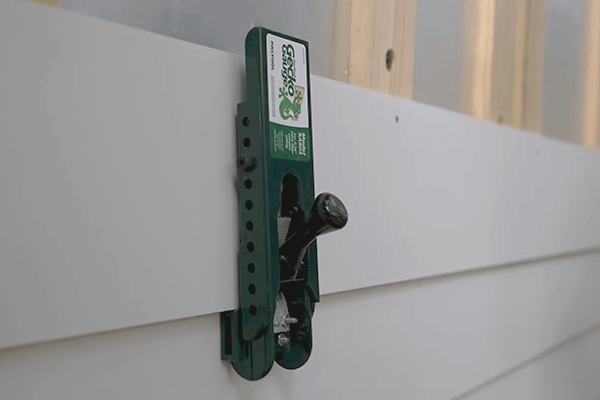Among other options, Hardie sidings are getting more popular among house owners by the day. There are multiple reasons why people choose this option over the others. However, it does have some limitations.
You can expect some serious moisture problems with Hardie siding, even though it’s installed properly. You can expect cracks, splits, molds, and mildews if the siding is exposed to moisture.
Let’s dig a bit deeper into the matter.

Contents
Moisture Problems With Hardie Siding
There are many issues with Hardie siding or fiber cement siding. However, the most common one is moisture issues. Many users have complained about cracks, splits, mold growths, etc.
The reason behind this is mainly the material. Fiber cement is made of wood pulp or sawdust. These ingredients are prone to absorb moisture. So, even with perfect installation, you can’t make this siding moisture resistant.
Some part of the siding will certainly come in contact with the ground. That’s where the problem starts. The ground is where the siding absorbs water, moisture, and snow. Besides, any part that’s exposed to rain can also cause these issues.
Another thing that comes with fiber cement sidings is that they take a long time to dry. So, if you live in a rainy area, you can expect some hassle because of wet sidings. The longer the sidings stay wet, the worse the condition will get.
However, it is possible to make the installation as solid as possible to prevent early damage. It’s very important that you don’t install Hardie sidings all by yourself. In addition, be aware of the limitations before spending your money.
How To Prevent Moisture Problems With Hardie Siding?
As I have mentioned before, it’s not entirely possible to protect Hardie sidings from moisture issues. But there are a few steps you can take to make it more solid. Most of them directly relate to installing them.
Let’s take a look at what precautions you can take to make them more durable.
- Never deviate from the manufacturer’s instructions. It’s essential that you follow every instruction the manufacturer has written for Hardie sidings. This can reduce the damage by a lot.
- Do not install Hardie sidings by yourself. In fact, make sure that the professional you’re hiring to do the job has particular experience with this type of material. This way, you can expect the best service, even if you need to pay a few extra bucks.
- Ensure to do perfect nailing by using the right materials.
- Re-check whether the underlayment you are using is suitable for fiber cement.
- Proper installation of the gutter system is essential to prevent moisture damage too.
- Use permanently flexible caulk where needed.
- Properly install all flashing and trim.
- Do not go for cheap siding materials.
- Stick to proper instruction to improve siding longevity and protect warranty offers.
Releated
Common Roof and Attic Issues to Fix
Should You Service Your AC Every Year
Does Homeowner Insurance Cover Water Damage from Rain
Other Issues With Hardie Siding
The sad thing is that the downsides of Hardie siding do not stop at moisture. There are a lot of things that can make you wonder whether it’s really worth the money or not. I’ve briefly discussed a few of them.
Maintenance
Hardie siding will come somewhere in the middle if we are using maintenance as an evaluating unit. Vinyl is the best material when it comes to maintenance. That means it doesn’t need any maintenance whatsoever.
Fiber cement, on the other hand, is a painted option. The issue with these options is that you have to repaint them. This doesn’t have to be every year. Depending on the material quality you’re going for, you may have to re-paint Hardie sidings after seven to ten years.
After a certain period, you will notice the paint fading and creating dents and chips. If you want your house to be looking the same as the time you created it, you have to repaint Hardie sidings.
You also need to keep the caulking in check. This ensures that moisture doesn’t get to the boards. Also, permanently flexible caulk is required for Hardie sidings.
Expensive
Hardie sidings are not only expensive but also costly to install. Let me break this down in detail. Most users who complain about their Hardie sidings are sufferers of imperfect installations.
The reason behind this is that most service providers are fairly new to this material and do not have enough experience in dealing with it. So, they’re often unsuccessful while installing the sidings.
This can cause long-term issues for the homeowners. So, the best thing to do in this matter is to hire a professional, which will certainly cost you higher.
To sum up, Hardie siding installation cost is another thing that gets added to the entire expense.
Frequently Asked Questions
Does Hardie siding absorb moisture?
The material which is used for making Hardie sidings causes these to absorb moisture. If any area is exposed to moisture, rain, or snow, the porous surface can absorb moisture. This can cause permanent damage to the sidings.
How often should Hardie sidings be painted?
It largely depends on the quality of the sidings you’re going for. But the time can range from 5 to 15 years. Note that if the sidings get damaged in-between and have small dents, you should cover them with paint.
Small damages won’t require the entire siding to be repainted. Covering the damaged area is enough for preventing further damage.
What are the common issues for Hardie siding caused by moisture?
If your Hardie sidings are exposed to moisture, you can experience various damages. For instance, cracks and deterioration are the most common things. Then there’s also the growth of molds and mildews.
Final Words
Despite having some great reasons for installing it, moisture problems with Hardie siding make it difficult for users. Other issues like the cost, the difficulty of installation, and moisture issues are some significant reasons for not choosing Hardie sidings. However, you can certainly reduce the degree of damage and make the sidings more durable. As long as you’re using a high-quality product and seeking help from a professional for installation, it shouldn’t be an issue for your home.
